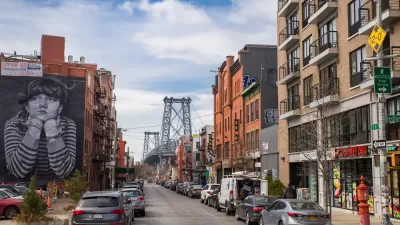Brooklyn and Queens need better transit, but activists say this waterfront "luxury trolley" is not the way to get it.
Though New York City has one of the more comprehensive and relied-upon public transportation systems in the U.S., parts of the outer boroughs have never been well-served by transit.
Given that, and given that streetcars have been a popular cause of the grassroots in a number of cities in the last decade, it may seem unlikely that community groups in Brooklyn and Queens are actively opposing a proposed streetcar line along the waterfront.
But New York City is different, and the BQX has never belonged to the grass roots. In a city with a demonstrated capacity for lots of subway and bus routes, the streetcar reads, to some, as sort of a stunt—a charming, unique mode of transportation serving quickly gentrifying areas. As Tyler Woods writes at Technical.ly Brooklyn, “it if the point of the project is really to upgrade transportation to those neighborhoods needing it most, that could be done more easily and less expensively in other ways.”
It does not help that the board of the organization pushing the streetcar, the innocuously named Friends of the BQX, is populated largely by representatives of some of the largest real estate companies in the city.
Woods quotes Tabitha Woods of TransitCenter:
"'The BQX corridor’s ridership doesn’t even come close to warranting a major capacity increase,' Decker explained in an email. 'The very features that will be required to ensure a streetcar is faster than a bus, namely true dedicated lanes, could be used to make the buses that currently run on that route faster and more reliable.'"
Considering the state of the subway system, the outer-borough streetcar may be losing popularity in general. "It’s unclear how the flashy and expensive BQX project would be affected by such a sentiment, if it lingers," Woods writes, "but…probably not helpful."
FULL STORY: Why some surprising people are really not into the BQX

Study: Maui’s Plan to Convert Vacation Rentals to Long-Term Housing Could Cause Nearly $1 Billion Economic Loss
The plan would reduce visitor accommodation by 25,% resulting in 1,900 jobs lost.

North Texas Transit Leaders Tout Benefits of TOD for Growing Region
At a summit focused on transit-oriented development, policymakers discussed how North Texas’ expanded light rail system can serve as a tool for economic growth.

Why Should We Subsidize Public Transportation?
Many public transit agencies face financial stress due to rising costs, declining fare revenue, and declining subsidies. Transit advocates must provide a strong business case for increasing public transit funding.

How to Make US Trains Faster
Changes to boarding platforms and a switch to electric trains could improve U.S. passenger rail service without the added cost of high-speed rail.

Columbia’s Revitalized ‘Loop’ Is a Hub for Local Entrepreneurs
A focus on small businesses is helping a commercial corridor in Columbia, Missouri thrive.

Invasive Insect Threatens Minnesota’s Ash Forests
The Emerald Ash Borer is a rapidly spreading invasive pest threatening Minnesota’s ash trees, and homeowners are encouraged to plant diverse replacement species, avoid moving ash firewood, and monitor for signs of infestation.
Urban Design for Planners 1: Software Tools
This six-course series explores essential urban design concepts using open source software and equips planners with the tools they need to participate fully in the urban design process.
Planning for Universal Design
Learn the tools for implementing Universal Design in planning regulations.
City of Santa Clarita
Ascent Environmental
Institute for Housing and Urban Development Studies (IHS)
City of Grandview
Harvard GSD Executive Education
Toledo-Lucas County Plan Commissions
Salt Lake City
NYU Wagner Graduate School of Public Service



























